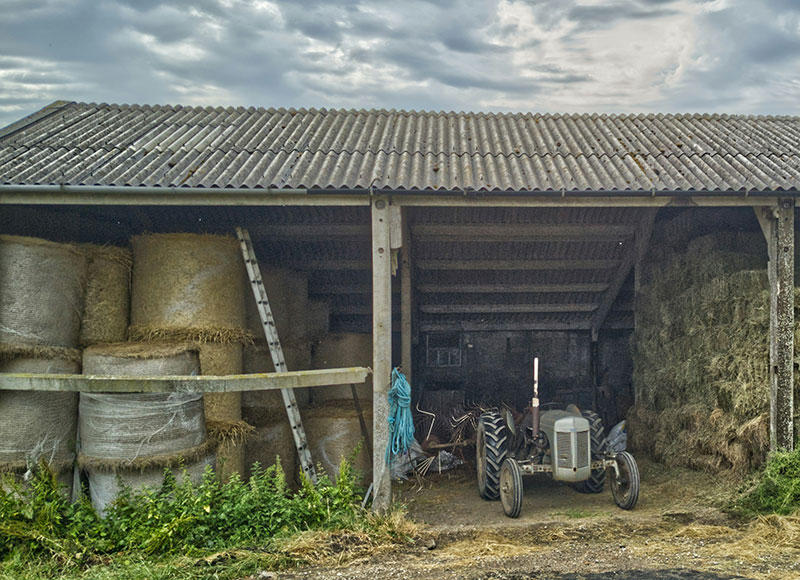How Do I Create an Asbestos Management Plan for a Farm?
Asbestos is a naturally occurring mineral that was once commonly used in the construction industry. While it’s not dangerous in a contained state, asbestos becomes a serious health risk when its fibres become airborne and are inhaled or ingested. This happens when an asbestos-containing material (ACM) breaks down over time or is damaged.
Asbestos exposure can lead to life-threatening, hard-to-treat illnesses decades in the future, including various types of cancer. Because of its severe health implications, the UK banned the use of asbestos in 1999, but many older farms and other structures are still likely to have ACMs. To maintain a safe environment for people to live, work, and visit your farm, asbestos must be located, assessed, and, if necessary, removed.
According to the Control of Asbestos Regulations 2012, there’s a legal duty for farm owners and tenants to manage asbestos on the premises. While certain procedures are not obligatory, such as having an asbestos professional conduct a survey, these steps are often necessary for the proper management of asbestos.
Where can asbestos be found on farms?
Older buildings, including farm buildings, typically contain ACMs. Common areas where asbestos is found on farms include:
- Building partitions
- Cement sheets and panels
- Downpipes
- Ducts
- Flooring adhesives and tiles
- Gutters
- Roof sheets and other roofing materials
- Wall cladding and insulation
Before it was banned in 2000, ACMs were used in the initial construction of farm buildings as well as in renovation projects. ACMs were also repurposed to use for repairs or to construct other buildings on the premises.
Additionally, it was once common to bury asbestos that was no longer needed instead of disposing of it properly, which can contaminate the soil.
What should I do if I suspect there’s asbestos on my farm?
Having an asbestos management company come to the farm to survey the property will either reassure you that there’s no asbestos present or discover the presence of asbestos, assess its condition, and help you create a plan for moving forward. Based on what’s found during the survey, you may need to create an asbestos management plan for your farm.
If asbestos is found, the first step is to write an asbestos register. This includes details like where the asbestos is located, the type of asbestos, and its condition. From there, an asbestos management plan will be devised.
It’s important to understand that undamaged or sealed ACMs don’t pose an immediate health risk and are often left untouched for safety reasons. However, damaged ACMs and ACMs that are likely to be damaged or disturbed should be removed.
Alternatively, the ACM may be encapsulated to prevent fibres from releasing. If removing the ACM is too high-risk a job or if the ACM is only slightly damaged, encapsulation may be a reasonable option.
What information should an asbestos management plan include?
An asbestos management plan details the arrangements and procedures you’ll follow to manage the risk from ACMs on your farm property. A thorough asbestos management plan will include the following, along with the name of who will be in charge of each part of the plan:
- The name of the person responsible for managing asbestos on the farm.
- The asbestos register, which should include a site plan that shows where ACMs were found and any areas not yet inspected.
- Prioritised actions to deal with ACMs that are creating an exposure risk.
- Planned work that could potentially disturb or damage ACMs that are currently in good condition.
- The best practices that will be followed to avoid disturbing ACMs that are currently in good condition.
- Your plans for sharing asbestos information with employees, contractors, and anyone else who’s regularly on the property.
- The schedule you’ll follow to monitor the ACMs.
- Emergency procedures in case there’s an accidental asbestos exposure event.
The asbestos management plan for your farm can be either a hard copy or an electronic copy. Whichever type of plan you decide to draw up, it must be easy to read, accessible to update as needed, and available to anyone who might want to access it.
What are the next steps to take after creating an asbestos management plan?
Of course, if there’s an asbestos exposure risk on the premises, you’ll want to hire an asbestos management company to devise a plan, remove the ACM, and make the building safe for reoccupation.
In addition to that, make sure to communicate with anyone on the property to let them know about the asbestos situation. Also, continue to review the asbestos management plan and the ACMs to prevent future issues.
Communicating with farm workers
It’s important that you let everyone on the farm know that ACMs are present, the dangers they pose, and how to avoid them. This includes contractors who are hired to perform a job, even if they’re not permanent employees of the farm.
Additionally, they should know what to do if they notice damaged ACMs, such as avoiding the area and letting the duty holder know about the situation immediately.
As the person in charge of asbestos management on the farm, it’s important that you clearly label all ACMs to help prevent them from being disturbed.
Reviewing the asbestos management plan
Part of asbestos management is to regularly review and update the plan. Over time, ACMs may become damaged, disturbed, or worn down. Regularly checking on the ACMs and updating the register and management plan accordingly is necessary.
Why is an asbestos management plan vital for farms?
Farms have a history of non-compliance when it comes to asbestos laws and management.
A contributing factor to this is that farms are often family-owned businesses. It’s common for a farm to never fall under new ownership, instead simply being taken over by another family member. Due diligence becomes lax in these cases.
Additionally, those in charge of farms that have been in the same family for generations may presume that they know everything there is to know about the property. They may assume that they know how the building was constructed, mistakenly believing that asbestos wasn’t used. Or, they may assume that there’s no asbestos on the property because they’ve never noticed ACMs in the past. These assumptions alone aren’t enough to consider a farm safe, though.
In addition to allowing unsafe conditions to go unchecked, this approach to asbestos management can create an issue if you choose to sell the farm. Buyers will want information about asbestos on the premises, requesting the asbestos register, past surveys, and other related paperwork. By not having these records available, the transaction could be delayed or canceled.
When should I hire an asbestos management professional?
Certain types of work, like that involving asbestos board, insulation, or sprayed coatings, can only be handled by a licensed asbestos expert.
Non-licensed individuals are legally allowed to handle less risky asbestos jobs on their own. However, before anybody works with asbestos, it’s important they receive awareness training to prevent exposing themselves or someone else to dangerous, toxic fibres.
It’s also likely that awareness training alone won’t be enough for an inexperienced person who plans to take on an asbestos task. Most likely, additional training will be needed before you can safely begin work.
While it’s smart for anyone who lives or works around ACMs to receive asbestos awareness training, it’s not recommended that they handle a removal job on their own. Even when it comes to lower-risk removal jobs, it’s always best to hire an asbestos management company. They’ll have the knowledge, equipment, and experience to safely carry out the job.
How can farmers ensure ongoing compliance and safety?
Managing asbestos on a farm is a necessary step toward keeping everyone safe from the life-threatening diseases that can arise from asbestos exposure. Staying compliant with asbestos laws also prevents the duty holder from facing fines or other punishments. Plus, should you decide to sell the farm or need to take out a mortgage on it, you’ll have to show that you’ve responsibly managed asbestos on the premises.
Most farms that pre-date 2000 have asbestos somewhere. The initial biggest questions to have answered are:
- How much asbestos is present?
- Where is the asbestos located?
- Is the asbestos damaged?
From there, you can begin crafting an asbestos management plan to ensure everyone’s safety. To learn more about asbestos management on your farm and to get a free quote, call us today.

Written by Brendan Coleman
Brendan Coleman, with decades of experience in the asbestos industry, is a dedicated Quality Manager. Certified as a surveyor and analyst, he is adept in operations and quality management with a keen focus on HSE compliance. His expertise is pivotal in maintaining high safety and efficiency standards. Brendan ensures our UKAS accreditation requirements are consistently met and exceeded, upholding stringent standards in asbestos remediation. His commitment to enhancing quality and customer satisfaction makes him an essential advisor in asbestos management.

